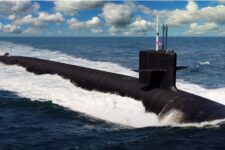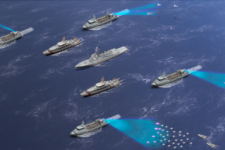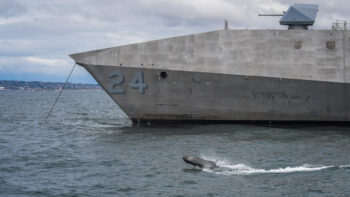
WASHINGTON: Iran’s threat to strangle oil tanker traffic through the Straits of Hormuz has the Navy scrambling to redress its decades-old neglect of mine warfare. Admirals from the Chief of Naval Operations on down have publicly admitted the service is not where it needs to be.
“What I find amazing is the amount of interest that’s being afforded mine warfare by the senior navy leadership,” said Scott Truver, a naval analyst and author. “It’s all due to the Iranian threat to close — if indeed it is possible to close — the Hormuz Straits.”
When asked point-blank whether he was “comfortable” with the Navy’s mine-clearing capabilities, the Chief of Naval Operations said bluntly, “No.” But, Adm. Jonathan Greenert went on in remarks at the Navy League’s Sea-Air-Space symposium last month, “I feel much better than I did six months ago. We’ve moved about a billion dollars total” from various accounts to weaponry for shallow-water warfare in places like the Gulf, and “a lot of that was in mine warfare,” Greenert said. “But we have more work to do,” he went on. “It’s not just the near term issue.”
The Navy’s long-term solution is a high-tech concept centered around the controversial Littoral Combat Ship, which will serve as a fast, albeit vulnerable, mothership for mine-hunting helicopters and a host of unmanned vehicles. That’s definitely more attractive than the traditional approach of sending minesweeping ships, divers, and even trained dolphins straight into the minefield. But the much-delayed mine-countermeasures module for the LCS is still in development, with extensive testing about LCS-2, the Independence, scheduled for this summer. Until it’s operational, the Navy’s counter-mine capacity remains distinctly limited.
“We’ve been doing mine countermeasures since 1917 and we still can’t get that package ready for production,” lamented naval historian and analyst Norman Polmar. For now, “14 minesweepers and two squadrons of helicopters are our nation’s entire mine countermeasures capability.”
In March, Adm. Greenert made a very public point of ordering more mine-hunting helicopters and ships to the Gulf, noting that the deployment would double the number of Avenger-class minesweepers operating out of Bahrain from four to eight. What he didn’t emphasize was that’s more than half the nation’s entire minesweeper force, leaving just two ships for training in the States and four in Japan to keep an eye on China’s estimated arsenal of 100,000 naval mines.
At the moment, moreover, the reinforcements for the Gulf are still en route — not under their own power but hauled aboard heavy-lift ships, since the small minesweepers aren’t well-suited to cross oceans on their own. The Navy continues to upgrade the 1980s-vintage minesweepers, recently improving their sonar for example. Overall, however, the Avengers are slow, vulnerable, and increasingly difficult to maintain.
By contrast, the LCS is brand new, much faster, and at least as survivable as the Avengers. The Navy rates both ships’ resistance to battle damage as “level one,” compared to the more resilient level two for the similar-sized Perry-class frigates and level three for the much larger Arleigh Burke-class Aegis destroyers. The LCS also has an anti-missile system and other self-defense capabilities the Avengers lack to keep from being hit. Moreover, the whole LCS concept of sending out unmanned submersibles and helicopters — the Avenger cannot do either — is meant to keep it further from danger in the first place. While the Pentagon’s own independent Director of Operational Testing & Evaluation has questioned the LCS’s ability to survive in a “combat environment,” even LCS skeptic Polmar admits it’s an improvement over the geriatric Avenger.
In the strategic big picture, however, the most important difference is that whereas the Navy has just 14 Avengers, it has committed to buying 55 Littoral Combat Ships. Not all 55 will be minesweepers: The LCS concept is “modular,” with each ship capable of being quickly re-outfitted to deal with either mines, submarines, or swarms of fast attack boats (all three are part of the Iranian arsenal, incidentally). The Navy plans to buy 24 mine-countermeasures modules, almost double the number of Avengers.
The devil is in the modules, however. Only the small-boat-fighting module has actually been deployed on a real-world operation, without its full complement of weapons. Work on the anti-submarine module was “reset” after the Navy changed its concept to better exploit LCS’s speed; delivery is not expected until 2016. Then there’s the mine countermeasures module, with two prototypes in testing and formal assessment by the Director of Operational Testing & Evaluation scheduled for 2014.
“The key piece for us is we now have the software that works,” said the Navy’s program manager for LCS modules, Capt. John Ailes, in a briefing at last month’s Sea-Air-Space convention. With the underlying software in place, he said, the Navy can keep plugging new capabilities into the module as they become available in a continuous cycle of upgrades. In May, for example, the Navy announced it was adding the “KnifeFish,” an unmanned submersible specifically designed to look for mines that are buried on the sea floor instead of floating, a task right now that can only be accomplished by trained dolphins and divers.
In the longer term, Navy officials talk about having unmanned mini-subs that can “porpoise,” briefly surfacing to transmit data back to the LCS for analysis before returning to their underwater hunt. With current technology, however, sailors with winches have to physically haul the drones back aboard to download the data. So at the moment, said Capt. Ailes, “the biggest challenge we have is launch and recovery” of the main unmanned mine-hunting submersible, the Remote Multi-Mission Vehicle (RMMV). “We can safely pick it up, we can safely put it down,” said Ailes “[but] we want to make it routine.”
Another mundane obstacle to the high-tech approach is that the LCS’s MH-60 Sea Hawk helicopter is simply a lot smaller than the MH-53E Sea Dragon that makes up the Navy’s existing — and highly regarded — airborne mine-hunting squadrons, which operate off big-deck amphibious warfare ships and carriers. Equipment optimized for the MH-53 needs to be resized for the MH-60, with inevitable losses in capability. Nevertheless, given that the LCS-based MH-60s will supplement the existing MH-53 units rather than replace them, the Navy’s mine-clearing capacity will still increase overall.
The nascent LCS fleet will face a complex juggling act learning how to use all these new mine-hunting capabilities and its anti-small-boat module and the sub-hunting system, whenever that is operational. In theory, a specialist mine warfare ship would be ideal. In practice, it’s only the multi-role potential of the LCS that convinced the Navy to buy them in numbers, and it’s only in numbers that a ship can create critical institutional mass.
Historically, mine warfare has been a marginal activity, conducted by a few sailors in a few ships far from the Navy’s power centers, aircraft carriers, submarines, and amphibious warfare ships. The fleet has occasionally had mine-warfare panics in the past — in 1950 after North Korean mines laid by wooden sailing junks kept Douglas MacArthur’s invasion force out of Wonsan; in 1991 after Iraqi mines damaged the ships Tripoli and Princeton — but the effort has always quickly flagged. “There was a lot of money thrown into mine warfare for three or four years and then attention turned elsewhere,” said Truver. “That’s my concern: That mine warfare’s going to be getting money but then, as priorities change, it’s going to be a backwater.”
After chilly silence, US SecDef, China defense minister hold first talks
Having regular mil-to-mil talks with China “is an important priority for us,” a senior defense official said, pointing to the PRC’s behavior in the South China Sea, as well as the importance of “peace and stability across the Taiwan Strait.”


























